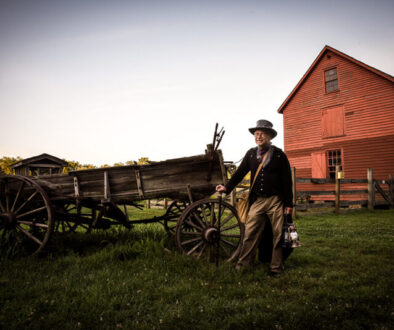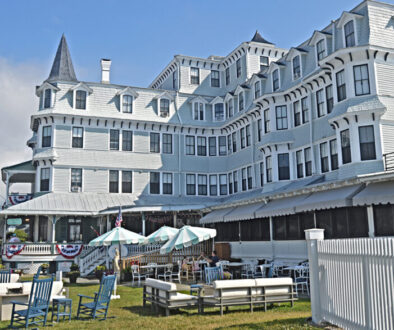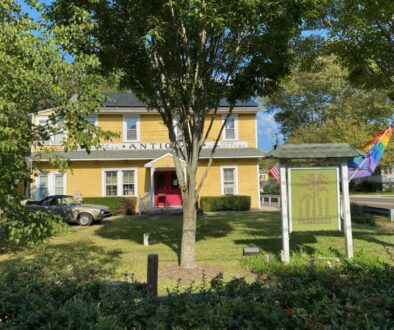Cape May: Beloved Destination for Both the Living & the Dead

Cape May is unique for plenty of reasons—it has the distinction of being the first seaside getaway in the country, is one of only 29 Coast Guard Communities in the US, and as a city, is designated a National Historic Landmark. But that’s not all. According to renowned medium, Craig McManus, it’s also noteworthy for having a ghost or… two.
“I feel Cape May is a paranormal hot spot in the United States,” says McManus. “There are many, but Cape May definitely has a prevalence of hauntings. There’s been a concentration of experiences and hauntings that people have had. I think maybe because it’s one of the oldest seaside resorts that people simply like to stay there. It has great energy, and that energy seems to entice people to stay even after they’re gone.”
While McManus has expertise in this field—he’s written no less than five books specifically about Cape May’s lingering spirits—even the layman gets a sense of the spookiness when walking through Cape May’s historic district at night. Even if you’re not a believer, the historic nature of the city lends itself to many a haunted tale. And for one that relies so heavily on tourism, ghosts are not bad for business.
“I used to go to Cape May when I was young,” says McManus. “At that time, the buildings might have looked haunted, but no one really talked about it.”
Back then, owners of historic bed and breakfast inns may have been reluctant to share ghost stories or anything that may have frightened away lodgers. With the advent—and popularity—of television shows like Ghost Hunters, Kindred Spirits, and Haunted Towns, the ghost business has gone mainstream. What was once taboo is now compelling, bringing in a whole new brand of tourist.
“When you mention ghosts and hauntings now, there are so many people who want to stay in haunted places,” says McManus. “They want the experience.”
And there are plenty of ways to get that experience. In addition to booking a stay at any of the reportedly haunted bed and breakfasts or historic inns throughout town, several tours are offered to provide information and entertainment to those interested in the eerie, unusual, and supernatural. As someone falling into that camp, this writer was thrilled—and appropriately fearful in the best possible way—to embark upon not one, but two uncanny trolley tours that plumbed the depths of Cape May’s haunted side.
The Spirits & Oddities Trolley Tour
Departing from the Washington Mall Trolley Stop across the street from Winterwood, the Spirits and Oddities Trolley Tour presented by Cape May MAC (Museums+Arts+Culture) is a dive into the macabre, mysterious, and just plain bizarre history of Victorian Cape May, all brought to life by a knowledgeable guide. In our case, the guide was Joyce Barth, a delightfully spirited woman dressed in head-to-toe black but for her white ghost earrings, and who has been leading tours with MAC for 31 years.
Along the route, Barth regaled riders with stories of local haunts interspersed with truly peculiar tales of Victorian customs. While most of the in-depth ghost stories are reserved for the Ghosts of Cape May Trolley Tour, there is plenty of ghostly information on this tour, which started off with the story of Penny the Cat, who haunts the George Ogden House.
Apparently, Penny, who was a gentle but enormous cat who passed away in 2011, can still be sensed by her owners, who have felt her jumping off furniture, moving through the home, and even offering the occasional “Meow.”
Penny is hardly the only pet haunting Cape May. On the tour, we learned about many pets still thought to be lingering at the Emlen Physick Estate, but even more jarring for 2022, we heard about the truly strange Victorian custom of anthropomorphic taxidermy. Though taxidermy itself isn’t unusual—there are plenty of hunters who display trophies like mounted deer heads on their walls, and many of us have seen displays of staged stuffed animals at museums—anthropomorphic taxidermy is the practice of stuffing and preserving the body of a dead animal but then giving them human characteristics.
So instead of seeing a small stuffed bobcat looking like…well, a bobcat, the Victorians may have posed the bobcat on a tufted chair, along with reading glasses and a glass of port. Barth described animals propped up playing croquet, others in wedding dresses, and still groups of others playing cards.



Anthropomorphic taxidermy was just one Victorian custom that dominated the era. Another interesting fad involved the treatment of the dead. Barth explained that during the Victorian era, grave robbery was prevalent, with robbers stealing jewels and belongings of the dead, as well as… the dead themselves. To prevent this, many wealthy Victorians chose to be buried in above-ground crypts, which were practically impenetrable. For those who weren’t so lucky—or wealthy—there were a number of inventive devices that could be purchased and added to one’s grave.
Enter the mort stone, the mort cage, and even the coffin torpedo. Both the mort stone and the mort cage, as described by Barth, were extremely heavy items—either stone or metal cage—placed on top of a grave to prevent access to the coffin. However, for the persistent and undeterred grave robber, Philip K. Clover of Columbus, Ohio, developed the coffin torpedo—a device that would fire lead balls into anyone who opened a coffin. As a bonus, all these devices would also protect the newly deceased from the undead.
And for those who were unfortunate enough to be buried alive—a regrettably common occurrence in the Victorian era—safety bells were placed above fresh graves with strings that connected to the interior of the coffins. Families often paid to have someone sit by the grave for 24 hours, in case the bell rang, resulting, as Barth explained, in the phrases “saved by the bell” and “the graveyard shift.”
Among other unfamiliar customs that were the height of popularity during the Victorian era, one seemed eerily familiar: photography, and photo modification. Though these days, our photo modifications come mostly in the form of using Snapchat filters to make ourselves look thinner, fuller, older, younger, with and without animal ears or angel wings or even like a chicken nugget, Victorian-era photo modifications often involved headless bodies holding their own noggins. As if that isn’t morbid enough, photography was new, and very expensive. Many people only had one photo taken of them in their whole lives, and it was often after they had died. These photos featured the deceased all dressed up with literally no place left to go, posed on settees and beds, sometimes with eyes painted on top of their eyelids so they didn’t appear quite so lifeless.
Barth made each story—and there were plenty more on this half-hour tour—come alive through her engaging style and clever one-liners. Neither frightening nor gruesome, the tour was filled with curiosities and little-known facts, adding an enticing chill to an otherwise warm Cape May evening.

The Ghosts of Cape May Trolley Tour
Also departing from the Washington Mall stop, the Ghosts of Cape May Trolley Tour has a similar setup to The Spirits and Oddities Tour—an open-air trolley full of the spectrally curious led by a driver and tour guide, in this case, Terrie Rosania, who wore a headband made of faux bats rather than ghost earrings. Based on the research and writings of McManus, this tour, while not frightening, is more shiver inducing.
Rosania set the tone for the tour by showing everyone on the trolley photos taken by previous riders of some of the reportedly haunted houses. Photos included unexplained lights, orbs, and unidentified objects—was that a shadow, a curtain, or a spirit coming out of a window? Right before departure, Rosania told the story of the house previously owned by S.R. Ludlam, infamous for being accused of setting the fire of 1878. He was found innocent.
“The woman who currently owns the house used to come with her grandchildren,” says Rosania. “All of them, when they were under five years old, said they played with a little girl with blonde curly hair.” Rosania explained that one day, a man showed up at the house and presented the owner with a photograph of a girl—all the grandchildren identified her as the girl they had played with as children. Apropos of the setting, the girl had been dead for quite some time.
Once the tour began in earnest, guests were treated to the enthusiastic telling of ghost stories at several stops throughout the city. While Rosania explained that there were over 600 homes in the historic district of Cape May and many of them were haunted, the tour would take us through just a few of those.
One of the first stops was at the Southern Mansion, which was built in 1860 by George Allen, who, Rosania explained, did quite a bit of partying in Cape May. Upon his death, Allen’s great niece, Ester (who also loved a party), took over the property until her death in 1949, when her husband sold it—furniture and all—for $8000 to a Mr. Curly. Curly, along with his wife, Mary, utilized the property as a boarding house. Now a stunning hotel, The Southern Mansion is still apparently home to some of its previous occupants. According to Rosania, both Ester Allen and Mary Curly still contentedly linger, happy to continue residing at The Southern Mansion. (And honestly, who wouldn’t be?)
From there, our tour stopped at the Emlen Physick Estate, where reportedly, nine spirits reside. In the summer months, pots and pans have been heard banging against one another, orbs have been seen under and around a dining table, a ghost dog has been spotted lying by the hearth, and the spirit of a woman can sometimes be glimpsed primping on the second floor. While none of the spirits have appeared angry or disgruntled, walking by The Physick Estate at night may give pause to the faint of heart.


From there, the stories rolled off Rosania’s tongue. From The Hugh—previously The Blue Rose—which is rumored to be haunted by Joseph Henry Hughes and his family; and The Columbia House, which, built by William Essen Sr. in the 1880’s, is said to be haunted by Essen Jr., who occasionally makes his presence known by messing with the microwave; to the Hotel Macomber, reportedly haunted by original manager Miss Sadie as well as several others; the Bedford Inn, which is reportedly haunted by Charles Page, who, during the one summer he sent his family to vacation in Cape May without him, was shot and killed at work in Philadelphia; and The Chalfonte, Cape May’s oldest running hotel, reportedly haunted by Mr. Johnson, the handyman, among others.
Rosania told several more stories, but apparently even those are just the tip of the iceberg. As McManus told us, “I could walk up and down any street in Cape May and tell you about hauntings…Cape May seems to draw in both the living and the dead.”
Get Your Ghost On
This autumn, as the weather cools and the shadows get darker, take a stroll or a trolley ride through Cape May, and see what—or who—you can discover.
In addition to the aforementioned tours, MAC offers several other ghost tours throughout the year including Historic Haunts House Tour, where guests tour select rooms and learn about Victorian Spiritualism in the Physick House Museum; Historic Haunts Combination Tour, a combination of Historic Haunts House Tour and Ghosts of Cape May Trolley Tour; Graveyard, Ghosts & Mansion Combo Tour, where guests hear the stories and experiences of ghost activity in the 1879 Physick House Museum, take a trolley ride to the historic Cold Spring Presbyterian Cemetery, and hear electronic voice phenomena recorded by tour guides and staff at the estate; and Ghosts of the Lighthouse Trolley Tour, where guests travel along the ghostly path that leads to the Cape May Lighthouse and hear the tales of brazen pirates, lonely maids, and Cape May ghosts.
And in October, the spookiest time of the year, MAC offers additional experiences like a Ghost Walk with Craig McManus and a Séance at the Physick Estate, also with McManus.
Summer beach vacationing is not the only appeal of Cape May—witness the number of visitors who have truly never left! ■




